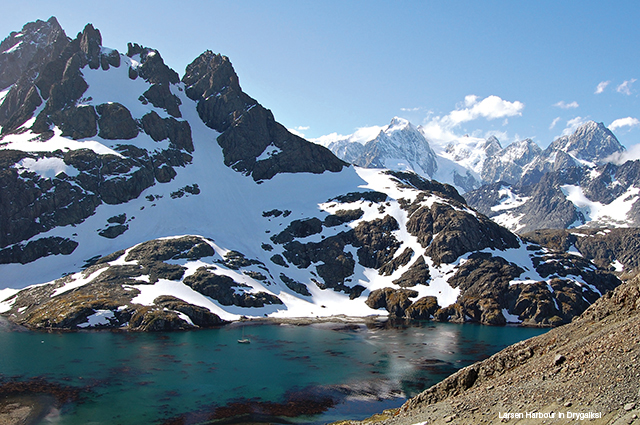Embracing the perils and rewards of South Georgia Island (published September 2012)
Visiting South Georgia Island, along with the wider Antarctic region, has been one of my lifelong dreams. I’ve always tried to avoid the “milk run” cruising routes in favor of places that serve up real adventure spiced with an element of danger. Growing up in New Zealand, South Georgia Island was the stuff of boyhood fantasy. The adventures of Cook, Shackleton and dozens of lesser known explorers gripped my imagination.
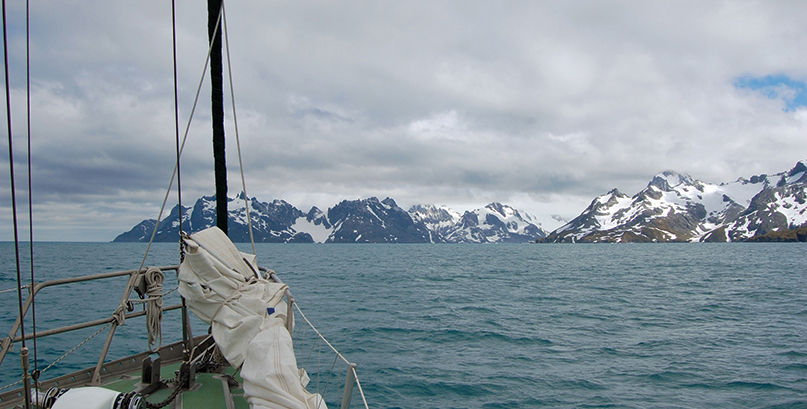
South Georgia is a mountainous island deep in the South Atlantic below the Antarctic Convergence. Its dramatic terrain hints of Antarctica proper. There is no permanent human settlement, although the unbelievably extensive local populations of albatrosses, penguins and seals find it perfectly suitable. Seals and whales particularly have been the cause of the island’s principle clashes with humanity—a handful of once sophisticated whaling and sealing stations remain at various inlets. All are now abandoned and decrepit, of historic interest only to intrepid modern-day visitors curious to meet their ghosts.
Kiwi Roa, sailed this trip by myself and two crew, had been in Patagonia for several years, and the Falkland Islands served as the base for our South Georgia expedition. Preparation was extensive, and a full assessment would date back to very early days. My 18-year-old boat is at heart an expedition yacht, of heavy aluminum construction and intended from the outset to handle the worst case scenarios possible. It’s my opinion that only metal hulls are appropriate for use in high latitude adventure cruising. But even with the right vessel, the list of provisioning for the trip on a sailboat just grows and grows: have we taken care of every contingency? And this was going to be a two or three-month outing.
MAKING DO
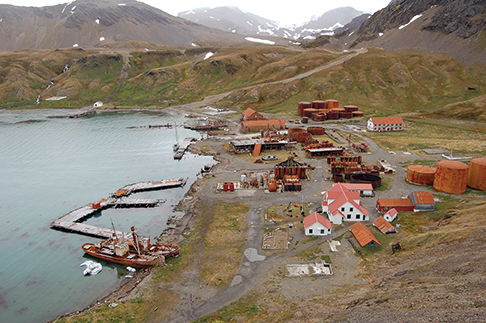
From the Falklands, South Georgia is about 800 miles distant, which reasonable weather saw us cover in less than five days. Kiwi Roa made landfall at sunrise, sailing east toward the light as it began to illuminate the jagged skyline. I now rate this landfall as the most spectacular I have made, beating out even some of the good ones from the South Pacific. As day broke, we ran east along the northern coastline, headed to the British station. Unfortunately, the uneventful passage wasn’t to remain so, and only four hours before making harbor, the boat’s otherwise reliable autopilot went a little nuts, causing a standing crash gybe in a freshening breeze—and the boom sheared in half at the bails. With no other damage, the boom’s aluminum sections would have to be jury-rigged ashore. Kiwi Roa has run up over 80,000 miles in her lifetime and been through some fairly rough weather, always performing as intended and never suffering any serious damage. Now, 1,000 miles from any serious support and in one of the most hazardous regions on the planet, we would have to “make do.”
At King Edward Point, the British Antarctic Survey has a research station staffed by a small group of scientists and administrators. South Georgia is a U.K. Overseas Territory administered by its own government based in the Falklands—we had the paperwork relating to our visit completed before we left. KEP is a tiny settlement comprised of just a few buildings with a dock for support shipping. The British have had representation here since 1909 and now the KEP people welcomed us warmly. I was able to gain the use of a basic workshop, some timber and fastenings to assist with a temporary repair to the boom.
At King Edward Cove, we were able to moor Kiwi Roa to an old semi-restored dock located at the head of the bay among the partially preserved remains of Grytviken, the old whaling base. Not reliant on the anchor, we nonetheless were exposed to South Georgia’s weather in short order. Landfall was made in beautiful conditions—albeit with strong winds, but nothing by the standards of the area. The cold air in the cove was soon whipping past at a good 50 knots, and that’s with some protection at the coastline. Out in the main bay the winds were much stronger; we saw salt water being blasted off the wave tops and lifted more than 150 feet in the air, driven like snow in a blizzard. Katabatic winds are notorious in these areas—strong gales reinforced by cold air sliding down the mountain slopes and glaciers and impacting the bays below. Our movements around the island were going to be held hostage by the inclement weather and requisite precautions.
HAZARDS & HISTORY
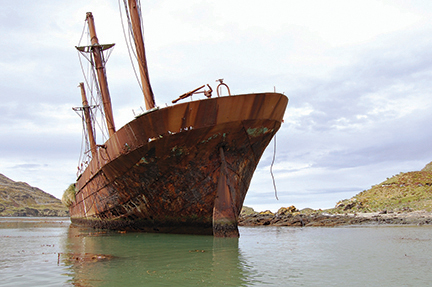
Our very first stop out of King Edward Cove contained one of many warnings to the visiting mariner on this issue of the weather. At Ocean Harbour, which used to have a small whaling station, is the wreck of the iron Bayard, a 220-foot, three-masted coaling ship originally launched in 1861. In June 1911, she was ripped by a winter gale from her dock on the other side of the harbor, and her 1,000 tons were driven with unstoppable force to the other side of the bay, where she has remained permanently beached to this day. Later on, we came across another dramatic symbol: the 1,700-ton iron Brutus, built in Scotland in 1883, which was driven off her place of intentional grounding (where she was being used as a coaling hulk) by a severe storm, pounded and beaten onshore at Prince Olav Harbour. The forces involved are not ones with which any sensible-minded sailor would dally.
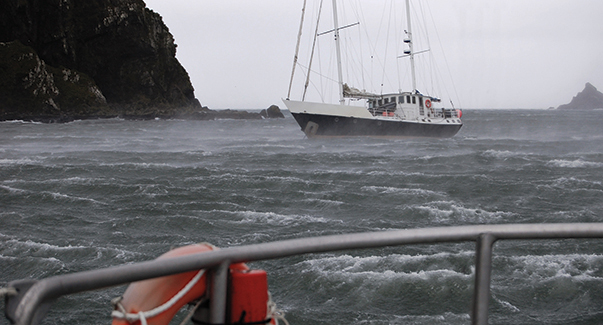
Kiwi Roa’s worst encounter with South Georgia’s challenging climate came toward the end of our stay, at the western end of the island in a place called Elsehul. This is a supposedly protected bay, but westerly and southwesterly gales are funneled over the saddle at its head, as we discovered. Anchored alongside Golden Fleece, the expedition charter yacht owned by renowned French explorer and sailor Jérôme Poncet, our Rocna anchor hung on through three days of constant storm and hurricane force conditions. In peak winds of about 80 knots at sea level, doing much outside is almost impossible. Operating cameras was impractical—and of a reduced priority, I hope the reader will understand—and photos were limited to quick snapshots peeking out the dodger looking downwind.
This remote island has a short but interesting history. Historians believe that an English merchant was the first to discover the island, by accident. A century later came Captain James Cook, returning to Britain with tales of the island’s abundant wildlife—particularly seals and whales—which caught the attention of another kind of mariner, a kind driven by the prospect of profit and armed with harpoons, clubs and knives.
Whaling made worthwhile the establishment of permanent land stations, the first of which were constructed in the first decade of the 1900s. Seven stations were operated under leases granted by the British until the end of the whaling industry in the 1960s. The bones of the settlements remain today, in varying levels of destruction: bizarre sights to see during our travels. We tended to spend time near them, as they were all built in obvious natural harbors. Old docks, however, were useless, and the structures themselves were dangerous and to be avoided.
Grytviken, the old base next to King Edward Point, is closely associated with famous British explorer Earnest Shackleton, and the doomed voyage of the Endurance—a tale known by any self-respecting boy with fantasies of a life at sea. After a failed trans-Antarctic expedition that resulted in the loss of their ship, Shackleton sailed a jury-rigged lifeboat from an island off the Antarctic Peninsula directly back to South Georgia, leading to the subsequent rescue of the stranded crew—and Shackleton, whose grave we visited at Grytviken, avoided even a single untimely death amongst his men.
That Shackleton could sail a leaky lifeboat 700 miles from Antarctica and successfully reach South Georgia, in an age with no electronic navigational aids, is deeply impressive. Just navigating the South Georgia coast in such circumstances would be remarkable. The land is, like the Antarctic Peninsula, essentially a range of sunken mountain tops. High peaks shrug off caps of ice, and the terrain is softened only by huge glaciers that grind valleys into the rock. Closer to sea level, the tundra allows some pathetic grasses and mosses to strain to turn the land green. There is little or no shelter from the wind, which is usually worsened by the funnels of the valleys and fjords, and ice is sprayed into the bays and coves by the glaciers that spill from the island’s interior.
ANIMAL KINGDOM
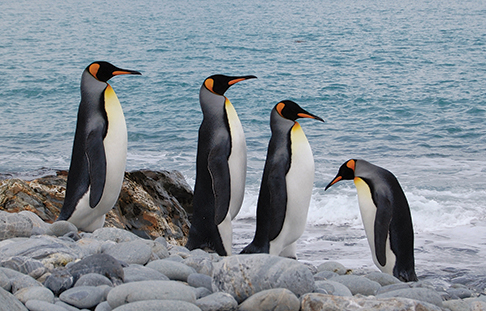
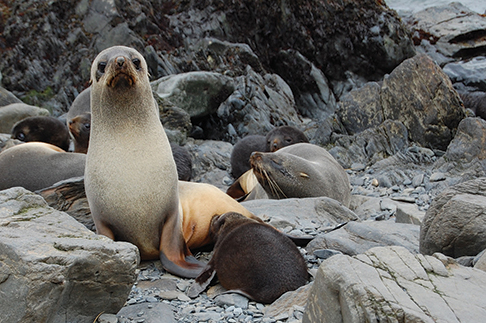
The place where la Roché clung to shelter in his 17th century merchant ship was probably the Drygalski Fjord, at the southeastern tip of the island. This rough extension of the island is steep, high, savage and raw, and split by deep waterways. As we approached, the clouds parted for us, fully exposing the mountain tops. Larsen Harbour, an inlet about two-and-a-half miles in length, was our anchorage of choice. We anchored Kiwi Roa on the moraine, which is marked chiefly by the presence of kelp, where the only holding in a reasonable depth may be found. In a bit of grim irony conspired to by glacial water and sunlight, the water looks tropical. The inlet serves as a wind funnel in a northwesterly, but otherwise was secure enough. Very well enclosed by the mountains, the harbor featured walls of rock and ice that were quite awe-inspiring.
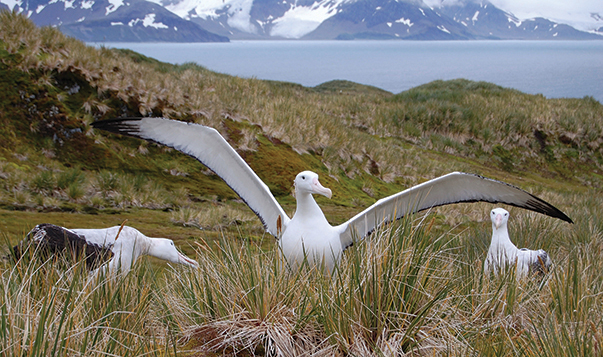
Among some of this dramatic terrain, South Georgia supports a range of Antarctic wildlife, principally seals, penguins and flying birds. Fur seals were once a principle draw of commercial attention, their populations recovering now but still decimated compared to the early days. Today they dot the beaches and headlands, seeming to enjoy lurking in the tussock. The unwary hiker may stumble upon a group and experience an ankle bitten by a curious or overly defensive “furrie”; it is necessary to carry a stick referred to as a “bodger” to fend them off.
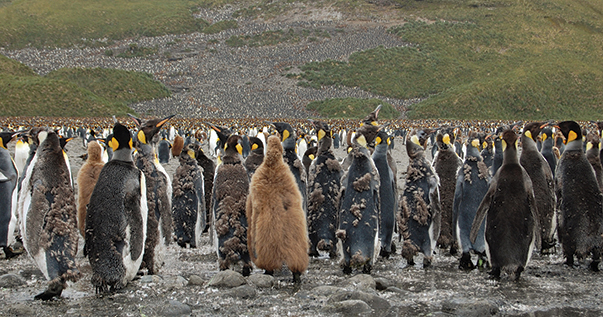
Penguins are found at most locations around the coast. Individual macaronis and kings are beautiful in form and endlessly entertaining in character. Kings were for me one of the more exciting examples of wildlife to view, and it is the kings that demonstrate the larger scale attractions: thousands and thousands of them. Several of the major colonies form vast expanses of feathers and beaks, crowding the beaches, extending inland, upland, everywhere. South Georgia is estimated to support a quarter of the world’s two million king penguin breeding pairs. Salisbury Plain, to which we hiked some three miles along the coast from a tenuous anchorage, all the while skirting and fending off aggressive furries, is the breeding site of more than 200,000 of them.
On the northern coast of South Georgia is a large, open bay filled with a number of small islands. Here are found the great wandering albatrosses that use a few isolated islands as their courtship and nesting bases. These giants are a birder’s fantasy to watch in the air. Although they can weigh over 22 pounds, their mastery of the wind currents and updrafts is complete. On the ground, these birds mate for life, part of the reason for their vulnerability to population reduction. This also means that courtship is critical, and we saw lots of it (but no bonding—the girls are hard to impress). Males try to attract attention by pouting out their chest and spreading their wings in full, demonstrating a wingspan that can be well over 10 feet.
There were other albatrosses at Elsehul, the site of our storm experience. Grey-headed albatrosses nest on the steep slopes amongst tussock, in locations protected from predators and accessible from the air. These birds have a softer look, with sooty grey heads and yellow highlights on their beaks. Their chicks, bundles of silly grey fluff perched like Russian dolls on their nests, know nothing but the ground before fledging some five months after hatching. Like their great wandering cousins, these birds are ranked as vulnerable in terms of conservation status.
WORTH THE TROUBLE
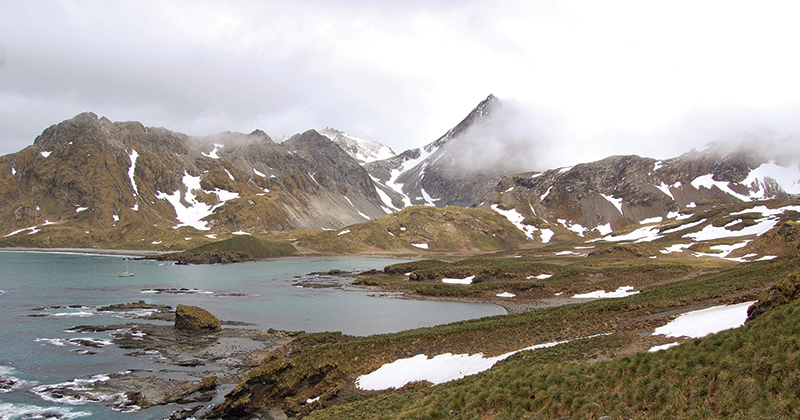
Planning the return passage to the Falkland Islands principally involved finding a weather window and accepting that a lot of it was going to be uphill. Systems moved through every few days, typically deep depressions with widespread precipitation and up to 50 knots of wind directly in the way. And once at sea, the ice had to be dealt with, increasing in quantity day by day as winter closed in. The big bergs were avoided easily enough, but they are responsible for cluttering up the sea to leeward with brash and growlers—constant vigilance was required.
At 55° south, approaching the Falklands, a system moving across the islands forced me to heave-to for a night in 45 knots of wind. Landfall the next day was made in huge seas, sleet and no visibility, the land completely obscured in freezing fog. Several knots of current setting the boat onto the coast was unhelpful. But South Georgia was a tremendously worthwhile destination, the sort of adventure that Kiwi Roa was intended for. Now back above the Antarctic Convergence probably for good, it is time to consider future voyages.
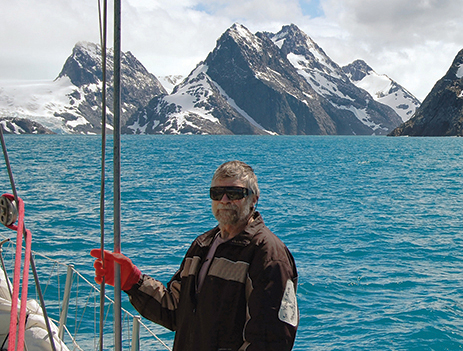
Peter Smith is a New Zealand boat builder, long distance cruiser, offshore sailor and designer of the Rocna anchor. Peter’s recent voyaging includes the 5,500 nautical mile passage across the torrid Southern Ocean from New Zealand to Chile. He’s spent three years exploring Patagonia and Tierra del Fuego, Antarctica, as well as the South Atlantic islands of the Falklands and South Georgia. Read more about Peter and Kiwi Roa’s voyaging and view many more photos from South Georgia at www.petersmith.net.nz
AN EXPEDITION YACHT
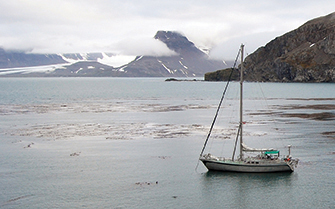
Self-built, Kiwi Roa is the result of Peter’s lifelong experience with both racing and long-distance cruising, not to mention professional boat building. She’s built mostly from 10mm aluminium alloy plate, although up to 25mm is used in some areas of the hull. She displaces 60,000 pounds and was built to go anywhere and handle the worst that the sea can throw at her. Kiwi Roa was envisioned as the ultimate oceangoing home, and Peter lives aboard permanently. Launched in England in 1994, she has since clocked more than 80,000 nautical miles and is still going strong.
LOA: 52’
Displacement: 60,000 pounds
Draft: 6’
Design: Custom one-off Tim Drury / Peter Smith
Construction: Aluminum plate
Rig: Sloop, all spars aluminum
To learn more about Kiwi Roa, visit www.petersmith.net.nz/about















